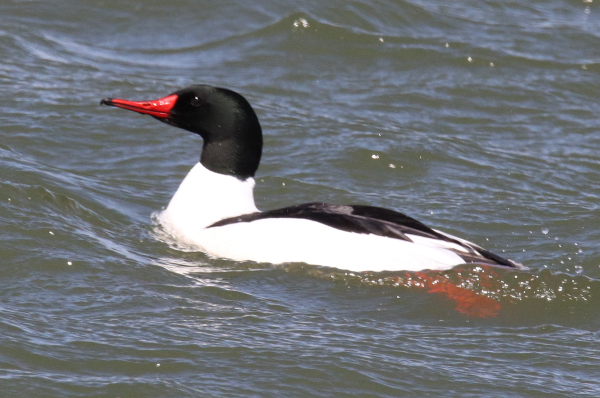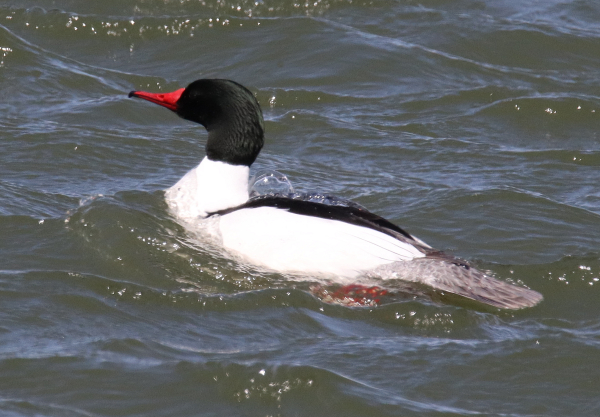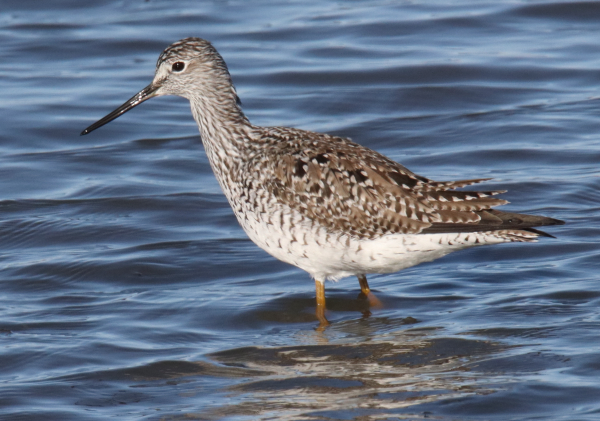
While trying to take photographs of Tundra Swans surrounded by Redheads as they fed in the shallows of Church Lake, I had better luck photographing another interesting species of waterfowl – Common Mergansers.

While photographing a female and 2 male Common Mergansers, I was surprised to see how much of these specially adapted ducks usually remains underwater while they swim. As you can see in this image, the entire length of their rump and tail feathers is submerged below the surface of the water.

When a third male landed next to the trio of mergs, he introduced himself with a tail-raised display that was not well received by the other males, and seemingly ignored by the female.

A surprise opportunity to take a fast-paced series of flight photos of an adult Ferruginous Hawk provided the inspiration and illustrations for the Bird Photography feature in the April 16 issue.

Each week more shorebirds are migrating this far north, numbering 6 species as of Tuesday, including Greater Yellowlegs (above), Baird’s Sandpipers, American Avocets, Wilson’s Snipe, Lesser Yellowlegs, and Killdeer.

The concentration of Bald Eagles an hour away continued to attract my attention, with the chance of taking striking photographs of eagles in a number of age groups ranging from yearlings to adult plumaged birds an obvious draw.
|
Note: There was a technical glitch that prevented last week’s Editor Afield article from being published, so we are giving it a second try to share the photographs and to keep you up to date on Paul’s weekly birding adventures. New birds of spring that appeared April 9th to 16th were a few Great Egrets, some Great Blue Herons, a Snowy Egret, American Avocets, Baird’s Sandpipers, Lesser Yellowlegs, Yellow-headed Blackbirds, a Turkey Vulture, and an early Loggerhead Shrike, on hand just 2 weeks after seeing the last Northern Shrike. The snow is gone and so are most of the geese, but there are still about 100 Snow and Ross’s Geese to the south and 50 White-fronted Geese a couple miles north. Now the 15 species of ducks dominate the avifauna, with Wood Ducks notably absent.
144 Bald Eagles! The concentration of Bald Eagles continues in the Hecla area, but in ever-fewer numbers but still providing thrills and photos when I return. The 144 count was a minimum present last Wednesday, and by Friday the eagles might have numbered closer to 10 percent of the original count of 618. I should note that the high count did not include eagles that must have been present at 2 excellent adjacent locations that I found a couple days later, and there were about 50 eagles in each of those locations. These 2 sites proved to be my favorite photography locations during this especially memorable and enjoyable Bald Eagle migration stopover.
During that Wednesday drive to Hecla, raptors numbered 9 American Kestrels, 8 Northern Harriers, 5 Red-tailed Hawks, 2 Sharp-shinned Hawks, 1 Ferruginous Hawk, and 2 Bald Eagles. There was also the Turkey Vulture, 5 Sharp-tailed Grouse, and 3 Tundra Swans of note. The Ferruginous Hawk was more than a mere sighting though; encountered south of home it provided a rapid-paced sequence of photographs during an episode I describe in this week’s Bird Photography feature.
The following day checked a number of locations during a birding drive to the southwest, then on to the northwest that yielded Tundra Swan groups of 38, 5, 36, 6, 2, and 2 among an abundance and variety of the ducks. But the real waterfowl gem was a partial-albino male Gadwall – an exciting find, but of course it was totally unexpected as it flew up among a large group of ducks. Colored white with an overcasting shade of tan, it looked like a young gull at first, so I raised my binoculars only to see the outline of a duck.
If I had known the bird was a rare duck rather than a young gull, of course I would have tried to take a couple documentary photos, but in hindsight, the duck was a long distance away and flew even farther away. When it landed I could see it separated from other ducks with a female Gadwall, hence the ID. I checked back with the hope of seeing and documenting the duck with the unusual leucistic plumage, but haven’t seen it again, yet.
My primary interest in heading northwest was to check on the 2 continuing Ferruginous Hawk nest sites. It seemed like it could be early for the species to be nesting in the area, but when I checked in April 10th both females were in incubating position on the newly renovated nests. One male was also present near the north nest. Apparently these were well-established pairs that migrated north early and jumped right into the nesting process.
A big bonus was finding a new Bald Eagle nest built between the 2 hawk nests – another case of a pair of Bald Eagles expanding a former Red-tailed Hawk nest into an eagle nest that measured at least twice as large. It has been quite a spring of expanding Bald Eagle nesting territories in the open plains of North Dakota! Keeping with the topic of nesting raptors, the nest day I checked back on the Red-tailed Hawk nest that traditionally is used by the earliest nesting pair of Red-tails, and sure enough, an adult was in incubating position on the nest. Another Red-tail nest in the area has had a Red-tail in attendance for a couple weeks, but there has been no indication of egg laying yet.
Swans & Mergansers
Saturday the sun began breaking through a bit about noon, which made me alert for the chance to see if there were any photo ops at Church Lake, where I observed a 38 Tundra Swans and a variety of ducks 2 days before. Sunlight broke through here and there, and along the way I observed many ducks and a late male Rough-legged Hawk on the hunt. From a distance, the sunlight looked good on the unnamed lake I refer to as Church Lake, but there was no sign of swans.
There certainly was the chance that they would resume their migration any day, but it turned out the big white birds had moved from the north shore where photos were not an option, to the east shore next to the road – what luck! There were 5 pairs of Tundra Swans feeding near the northeast shore, but the sun was clouded as I passed by the waterfowl that also included Lesser Scaup, Redheads, Canvasbacks, along with a few Common Goldeneyes and Common Mergansers.
As I waited for the sunlight to break through, I drove along the southwest side of the lake and counted a dozen more Tundra Swans in the distance, far removed from the others. As I headed back to the original pairs of swans, the sun broke through the ever-changing cloud cover and I advanced to try to photograph the southern-most swans. They weren’t receptive and stopped feeding to turn away from the road; so not wanting to disturb their feeding, I tried the pairs a little farther north, but was met with the same reception. I took some photos of a couple pairs, but I wished for some additional action from the big white waterfowl.
With the intent to return, I drove to the next large unnamed lake, where I photographed some scaup, then checked back on the swans. I drove past the swans to begin with to see how they would react, then reversed course and pulled up to the southern-most pair again. This time the swans were uneasy, stopped feeding, turned away a moment, and thereby gave me a chance to take couple photos, and that’s when the female’s demeanor changed in my favor. She returned the few feet to resume feeding, dipping her head and long neck below the water, raising it again and “paddling” her feet to churn the mud at the bottom, dipping to feed again, and repeating the process as the male looked on.
Also looking on was a small group of Redheads that began cautiously swimming toward the feeding swan. That’s when my photography became more interesting, with the Redheads surrounding the big swan, closer and closer, with some diving below the surface for morsels displaced by the swan’s paddling. What fun to see this activity and to have the swans warm up to my car’s arrival so I could take some photos of the action and interactions.
Having noticed a pair of Common Mergansers as I was approaching the swans, I checked back on them to find there were now 2 males and a female, and they provided some swimming portrait photos that were somewhat revealing. Revealing in that I could see the mergansers actually have a longer tail than is revealed when they swim on the surface of the water. In fact, they usually hold their rump and tail feathers underwater as they swim, a behavior I documented with my photos.
That’s when a third male flew in to land with a big splash near the merganser trio. He approached the others with his tail held high, something of a display, perhaps to communicate to the female or to all the mergs in some way. That’s when the other 2 males swam toward him, with 1 lunging forward and the 2 interacting aggressively with water splashing – and then they all took flight. It was another insightful birding episode to witness.
As for songbirds, a small flock of American Tree Sparrows was a nice find on Thursday, and Saturday a couple American Robins spent an hour displaying and fighting over a line of territory in my yard. A male Common Grackle displayed intently to a female that seemed especially irritated at the prospect, as 2 Dark-eyed Juncos foraged nearby. There was also a small flock of 4 Yellow-headed Blackbirds, the first of the season, just a mile south of home. After the robin skirmish Saturday, a male American Robin was bringing light nesting material to an undisclosed location in my backyard – it didn’t disclose the position of it to me anyway. But it seemed kind of funny that the robin would be gathering nest material without a female in sight yet – hmm.
It’s always a special day when the first Swainson’s Hawks appear, which can be any day now as they complete or continue their migration from the grasslands of northern Argentina. They spend our winter on the pampas, but it’s South America’s summer then (what, they manage 2 summers per year?). I always figure April 20th as the average first sighting date for Swainson’s Hawks, so they should be plying the northern plains sky any day now. It’s certainly an exciting time to be a birder, with new species and exciting behaviors to observe, and it just keeps getting better week after week. Enjoy the birds around you.
Article and Photos by Paul Konrad
Share your bird sightings and photographs at editorstbw2@gmail.com